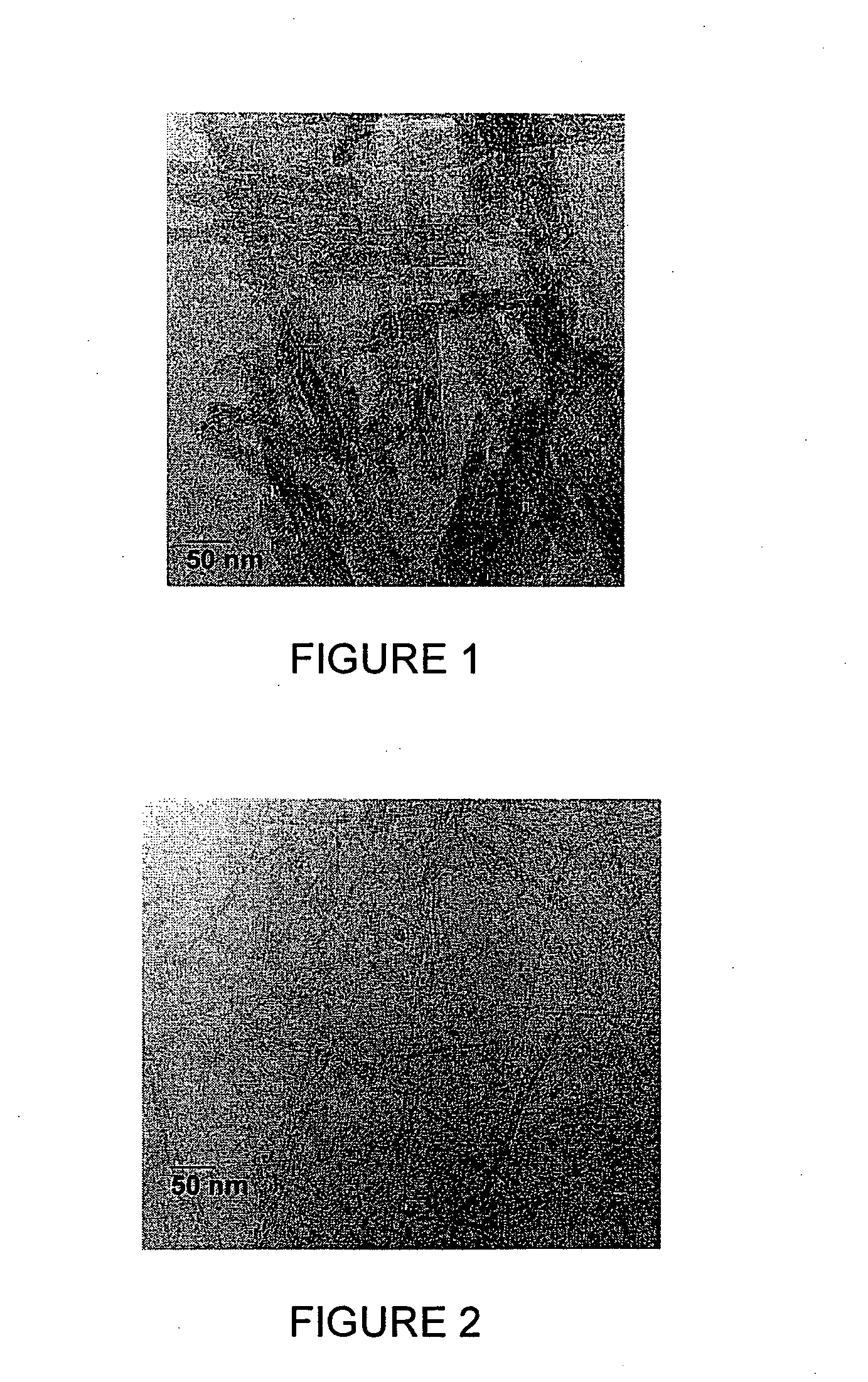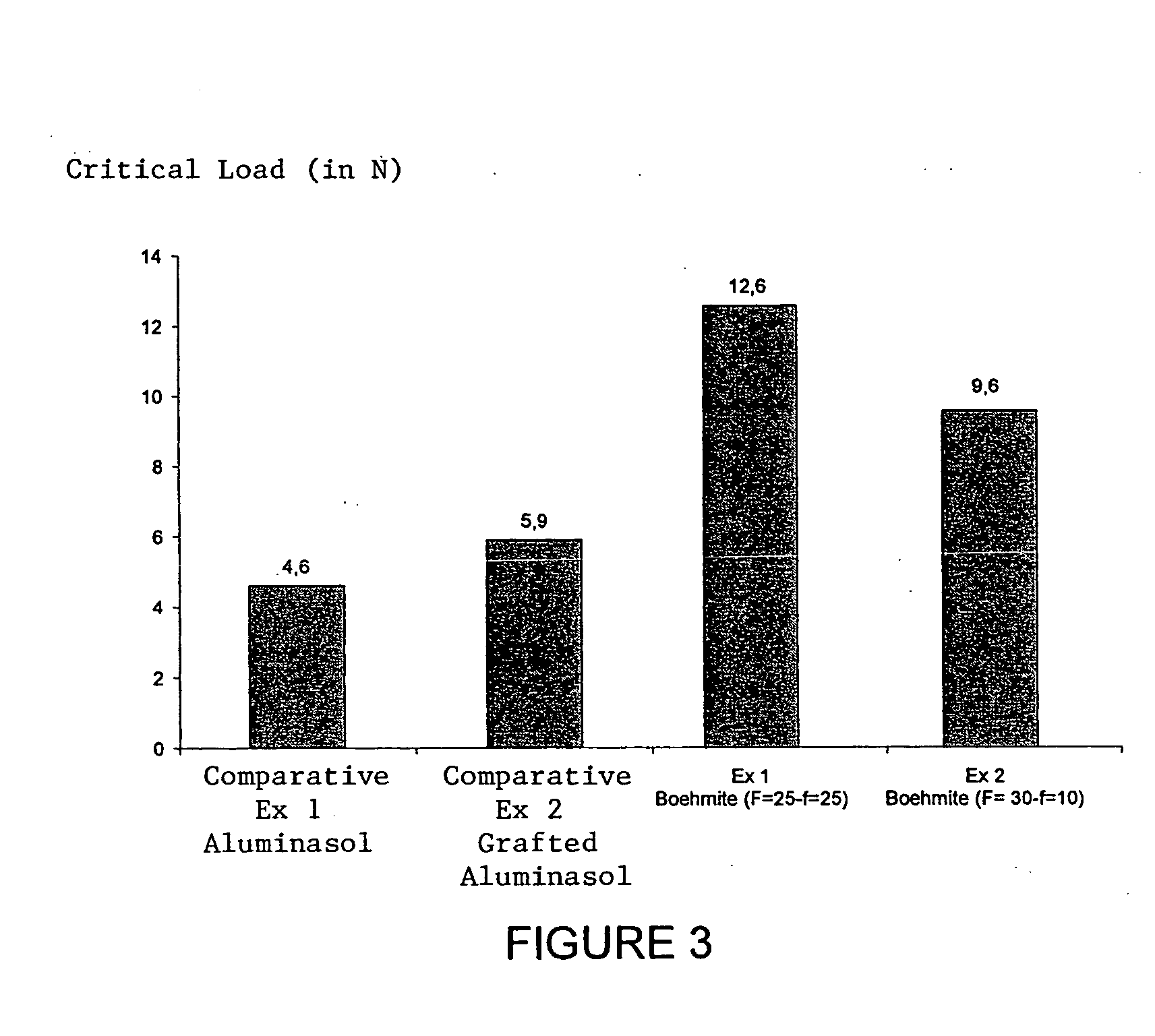Anti-scratch coating composition containing anisotropic particles, a corresponding coated substrate and its application in ophthalmic optics
a technology of anisotropic particles and coating compositions, applied in soil conditioning compositions, instruments, transportation and packaging, etc., can solve the problems of difficult to obtain good electrostatic and scratch-resistance properties, difficult to translate, and particularly delicate problems, and achieve the effect of improving adhesion
- Summary
- Abstract
- Description
- Claims
- Application Information
AI Technical Summary
Benefits of technology
Problems solved by technology
Method used
Image
Examples
example 2
Elaboration of Glymo Films Loaded with Boehmite Particles of of Form Factor F=30, f=110 Glymo Grafted
2.1. Synthesis of the Anisotropic Particles.
[0177] 13.5 g of basic aluminum acetate ((CH3CO2)2AlOH, Aldrich, CAS 142-03-0) are mixed with 300 mL distilled water and 1,89 mL nitric acid (HNO3 70%, SdS, CAS 7697.37.2). The mixture is left to stir for a further 10 min, then the whole is placed in an autoclave for the hydrothermal treatment. The duration of the treatment is 24 hours.
[0178] The solution thus obtained is dialysed for 48 hours in demineralised water.
[0179] The particles obtained have a form factor F=30, f=10 for an average length of 180 nm.
[0180] These particles are represented on FIG. 1.
2.2. Functionalisation of the Anisotropic Particles.
[0181] These particles are transferred in ethanol by successive spin-coating—re-dispersion operations.
[0182] 5.4 g boehmite are re-dispersed in 500 mL ethanol. One adds then 12.5 g glycidoxypropyltrimethoxysilane (ALDRICH). The s...
example 3
Elaboration of Methyltriethoxysilane (MTEOS) Films Loaded with Boehmite Particles of Form Factor F=25, f=25 Grafted with (3-methacryl-oxypropyl)trimethoxysllane
3.1. Synthesis of the Anisotropic Particles.
[0192] 13.5 g of basic aluminum acetate ((CH3CO2)2AlOH, Aldrich, CAS 142-03-0) are added with 300 mL distilled water and 1.89 mL nitric acid (HNO3 70%, SdS, CAS 7697.37.2). The mixture is left to stir for a further 10 min, then the whole is placed in an autoclave for the hydrothermal treatment. The duration of the treatment is 3 hours.
[0193] The solution thus obtained is dialysed for 48 hours in demineralized water.
[0194] The particles obtained have a form factor F=25, f=25 for an average length of 180 nm.
3.2. Functionalisation of the Boehmite Particles of Form Factor F=25, f=25 with (3-methacryloxypropyl)trimethoxysilane.
[0195] The boehmite particles synthesised previously are transferred in ethanol by successive spin-coating and re-dispersion operations.
[0196] 1 gram Boeh...
PUM
| Property | Measurement | Unit |
|---|---|---|
| sizes | aaaaa | aaaaa |
| temperature | aaaaa | aaaaa |
| temperature | aaaaa | aaaaa |
Abstract
Description
Claims
Application Information
 Login to View More
Login to View More - R&D
- Intellectual Property
- Life Sciences
- Materials
- Tech Scout
- Unparalleled Data Quality
- Higher Quality Content
- 60% Fewer Hallucinations
Browse by: Latest US Patents, China's latest patents, Technical Efficacy Thesaurus, Application Domain, Technology Topic, Popular Technical Reports.
© 2025 PatSnap. All rights reserved.Legal|Privacy policy|Modern Slavery Act Transparency Statement|Sitemap|About US| Contact US: help@patsnap.com



